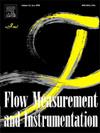Modification of the method for determining the flow coefficient K of an Iris damper with a flowmeter with consideration for its applicability in a wider measurement range
IF 2.3
3区 工程技术
Q2 ENGINEERING, MECHANICAL
引用次数: 0
Abstract
In industrial practice, among many types of measuring devices, a significant group comprises instruments for measuring velocity as well as single-phase and two-phase flow rates. Due to numerous measurement challenges, manufacturers of such equipment strive to obtain highly accurate measurement results while keeping the devices simple in structure and operation. Several measurement methods meet these criteria. One proposed measurement device based on pressure difference measurement is the commercial Iris damper with a flowmeter. The authors of a notable study conducted research on this flowmeter under atypical flow conditions. Additionally, they modified the method of determining the correction coefficient K for this type of flowmeter, which represents a novelty in their work. The obtained measurement results indicate the possibility of applying this measurement device in a significantly wider range of flow rates than specified by the manufacturer. The investigated Iris flowmeter can be a suitable instrument for measuring gas flow rates up to 600 l/s, while simultaneously exhibiting a measurement uncertainty of 0.5 % of the measured value.
求助全文
约1分钟内获得全文
求助全文
来源期刊

Flow Measurement and Instrumentation
工程技术-工程:机械
CiteScore
4.30
自引率
13.60%
发文量
123
审稿时长
6 months
期刊介绍:
Flow Measurement and Instrumentation is dedicated to disseminating the latest research results on all aspects of flow measurement, in both closed conduits and open channels. The design of flow measurement systems involves a wide variety of multidisciplinary activities including modelling the flow sensor, the fluid flow and the sensor/fluid interactions through the use of computation techniques; the development of advanced transducer systems and their associated signal processing and the laboratory and field assessment of the overall system under ideal and disturbed conditions.
FMI is the essential forum for critical information exchange, and contributions are particularly encouraged in the following areas of interest:
Modelling: the application of mathematical and computational modelling to the interaction of fluid dynamics with flowmeters, including flowmeter behaviour, improved flowmeter design and installation problems. Application of CAD/CAE techniques to flowmeter modelling are eligible.
Design and development: the detailed design of the flowmeter head and/or signal processing aspects of novel flowmeters. Emphasis is given to papers identifying new sensor configurations, multisensor flow measurement systems, non-intrusive flow metering techniques and the application of microelectronic techniques in smart or intelligent systems.
Calibration techniques: including descriptions of new or existing calibration facilities and techniques, calibration data from different flowmeter types, and calibration intercomparison data from different laboratories.
Installation effect data: dealing with the effects of non-ideal flow conditions on flowmeters. Papers combining a theoretical understanding of flowmeter behaviour with experimental work are particularly welcome.
 求助内容:
求助内容: 应助结果提醒方式:
应助结果提醒方式:


